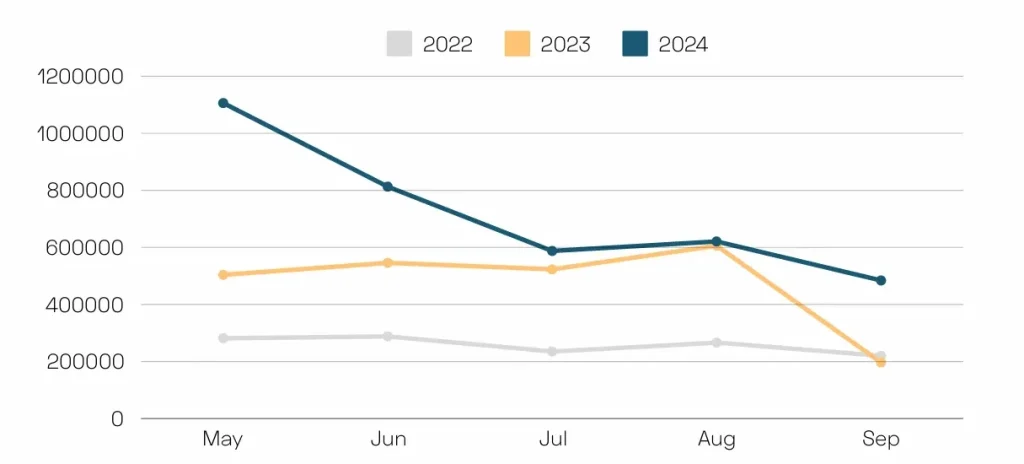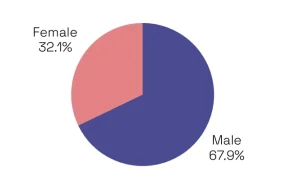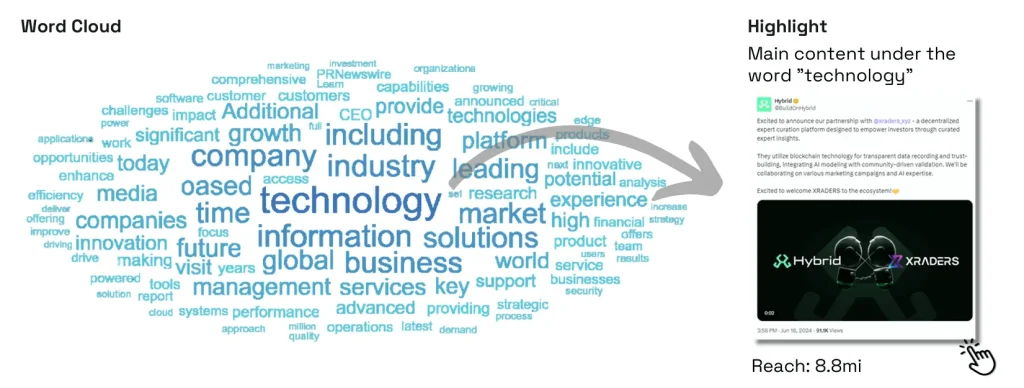Artificial Intelligence (AI) isn’t just a passing trend—it’s a tool that’s shaping the future of business. In marketing, especially when combined with social listening, it offers real-time insights into customer opinions and market trends. With the ability to quickly analyze massive amounts of data, it helps marketers make better-informed decisions, personalize interactions, and predict future behaviors.
In this blog, we explore how AI is reshaping the marketing landscape by enhancing social listening capabilities and providing crucial insights for decision-makers. Whether you’re looking to improve customer interactions, identify market opportunities, or simply stay ahead of the competition, this post offers practical tips on how to effectively leverage AI.
Understanding the Fundamentals of Artificial Intelligence
Artificial Intelligence, is a collection of technologies that enable machines to mimic human intelligence. These technologies include machine learning, natural language processing (NLP), and predictive analytics. In marketing, it allows brands to analyze large volumes of data, automate repetitive tasks, and predict future trends with remarkable accuracy.
It’s particularly useful in marketing because it enables companies to:
- Automate customer interactions: From chatbots to personalized emails, AI can simulate human interactions and create more personalized experiences.
- Analyze vast amounts of data: AI algorithms can sift through terabytes of data, identifying patterns that humans would likely miss.
- Predict market trends: With predictive analytics, companies can forecast demand, consumer behavior, and even potential market disruptions.
We monitored conversations from May to September 2024, and mentions of AI on social media skyrocketed, reaching over 1.1 million mentions—nearly doubling the volume from 2023 (504,037) and quadrupling 2022 (281,893).


AI and Social Listening: 2022 to 2024


Between May and September, there were over 6.28 million mentions from 718,310 unique authors, reaching an audience of 3.1 billion and generating 13.56 billion impressions. The majority of participants were male (68%), and the top interests included Business (27%) and Technology (21%), highlighting the growing impact of AI in these fields.
Overall, the data underscores AI’s transformative role in social listening, driving strategic insights and reshaping customer interactions.


These conversations were primarily driven on X (formerly Twitter), which accounted for over 1.2 million mentions, followed by YouTube. Sentiment fluctuated throughout the period, with most mentions leaning neutral or positive, indicating a balanced yet optimistic view of AI’s impact.


Social Listening powered by AI: Transforming Decision-Making and Identifying Opportunities
Social listening involves monitoring digital conversations about specific topics, brands, or industries. Traditionally, marketers relied on manual analysis or basic tools to interpret these conversations, which was time-consuming and often missed critical insights. Today, it is revolutionizing social listening, enabling marketers to analyze data in real-time, identify emerging trends, and gain valuable insights for strategic decision-making.
Key Benefits of Artificial Intelligence in Social Listening:
- Real-Time Insights: Can instantly process vast amounts of data, allowing marketers to adjust their campaigns based on consumer feedback in real-time.
- Sentiment Analysis: It’s possible to gauge the tone of conversations, distinguishing between positive, negative, or neutral mentions. This enables marketers to quickly respond to crises or capitalize on positive trends.
- Trend Identification: By analyzing large-scale conversations, AI can detect emerging trends that may not be immediately obvious. This ability to spot new opportunities is one of the most powerful aspects of combining it with social listening, often enabling a brand to stand out from its competitors.
Example:
Between May and September 2024, the use of AI in social listening helped professionals adjust their strategies in real-time. The report identified that discussions around Artificial Intelligence and ethics were among the most talked-about topics during this period. Other terms also emerged, such as technology, business, information, and solution.


How to Create Effective Artificial Intelligence Prompts: Strategies for Success
One of the most practical ways to leverage Artificial Intelligence in your marketing strategy is by using well-structured AI prompts, whether for customer service, content creation, or social listening.
But what are Prompts?
In the world of Artificial Intelligence, prompts are the instructions or commands you provide to guide the AI in generating specific responses. However, crafting effective prompts goes beyond simply asking questions. To receive relevant answers, it’s crucial to know how to provide the right information and guidance. This process, known as AI prompt engineering, focuses on creating strategic prompts to direct machine learning models (MLMs) and large language models (LLMs) toward achieving the desired outcome.
Rather than just asking a question, well-crafted prompts act as indirect programming, leading to more precise and relevant responses.
Why Are Prompts Important?
As we mentioned earlier, prompts guide AI in generating precise and relevant responses. Unlike “searches,” where you look for information on a specific topic using keywords and receive a list of results that somewhat match your query, AI prompt engineering is direct and leads to a specific response.
It’s important to note that the quality of the prompt directly impacts the quality of the AI’s output. For instance, if you’re using Artificial Intelligence to analyze social media mentions, a poorly structured prompt might result in vague or incomplete insights, while a well-crafted one can uncover specific and actionable data.
If you’re new to prompt creation or looking for quick tips on writing effective AI prompts, we’ll share some helpful guidelines in the next section to help you craft your own prompts.
Tips for Creating Effective Artificial Intelligence Prompts:
The best AI prompts start with a good question, but there’s much more to it. Here are a few tips to help you improve your prompts:
- Be Specific: Vague prompts like “What are people saying about my brand?” lead to generic outputs. Instead, try something like, “What are the main complaints about our new product over the last 48 hours on Twitter?”
- Use Context: Artificial Intelligence works best with context. Include details like:
-
- Industry: What sector/industry are you interested in? Retail? Healthcare? Technology?
- Region: Are you focusing on a specific country or geographic area?
- Target Audience: Who is your target audience? Gen Z? Professionals? Seniors?
- Timeframe: Are you analyzing data from the last two years? The next five years?
-
- Test and Optimize: Prompts often need refining. Start with broader questions and then narrow the focus based on initial results.
With the guidance above, let’s explore an example of how to craft effective AI prompts:
Example:
Imagine we want to understand the key trends shaping consumer preferences in the North American market over the next five years.
Enhancing Your Prompt-Writing Skills:
Let’s break down how the fundamentals can guide different sectors and teams, including a research team at a consultancy, a marketing team in the beverage sector, and an innovation team in the electronics industry.
Crafting Prompts for a Consulting Research Team:
An analyst at a consultancy wants to explore the fall beverage market, focusing on Pumpkin Spice Latte (PSL) in the U.S.
- Initial Question: What are the current and future trends for fall beverages in the U.S.?
- In the Form of a Prompt: Show me the current and future trends for fall beverages targeting consumers in the U.S. market.
- Applying the Four Fundamentals: What are the current and future trends for fall beverages in the U.S.? Based on this information, develop a strategy to promote our new fall-themed beverage line.
Crafting Prompts for a Fashion Marketing Team:
A clothing brand in Canada wants to expand its customer base, focusing on Gen Z.
- Initial Question: How can brands connect with Gen Z?
- In the Form of a Prompt: I want to expand my customer base by targeting Gen Z in Canada. How can I attract this audience through brand communication?
- Applying the Four Fundamentals: I want to expand my customer base, focusing on Gen Z in Canada. How can our brand communication resonate with this audience? Based on this, suggest an action plan, prioritizing the most relevant steps.
Crafting Prompts for an Electronics Innovation Team:
An innovation team is tasked with developing a new smart device for remote professionals in the U.S. They want to gather as much information as possible to create a relevant product.
- Initial Question: What smart devices are popular among remote professionals?
- In the Form of a Prompt: I want to develop a smart device for remote professionals. How should I start?
- Applying the Four Fundamentals: I want to develop a smart device for remote professionals in the U.S. First, tell me what the primary needs of this audience are. Then, generate three product ideas based on these needs.
How to Handle Challenges When Creating Prompts
One of the most common challenges in AI prompt creation is balancing clarity and conciseness. While it’s important to provide detailed context, prompts that are too long or vague can confuse the Artificial Intelligence or lead to imprecise responses. The key is to create a prompt that is clear yet direct, allowing the Artificial Intelligence to understand your goal without getting lost in unnecessary details. If the initial result doesn’t fully meet your expectations, you can always adjust and refine the prompt throughout the process.
Ethics and Diversity in Artificial Intelligence Implementation
While Artificial Intelligence offers immense potential, marketers must address ethical concerns, particularly around bias and diversity. AI models learn from the data they’re trained on, meaning biased or incomplete data can lead to skewed outcomes. For instance, an Artificial Intelligence system might disproportionately favor certain customer segments while overlooking others, resulting in ineffective marketing strategies.
Artificial Intelligence and Ethical Considerations:
- Data Bias: If your AI is trained on biased data, its insights will reflect that bias. It’s crucial to ensure diversity in data sources and conduct regular audits of AI models.
- Transparency: Consumers are increasingly aware of how their data is used. Being transparent about the role AI plays in data collection and analysis can build trust with your audience.
- Inclusive Design: Ensure that your AI tools and social listening platforms are designed to serve a diverse audience. This includes accommodating different languages, cultural contexts, and accessibility needs.
According to the latest data, 53% of consumers feel excited about Artificial Intelligence, while 50% express nervousness due to concerns about data privacy and ethical use. Marketers who address these concerns transparently can build stronger and more trustworthy relationships with their audience.
The Future of Artificial Intelligence and Social Listening
As Artificial Intelligence continues to evolve, its role in social listening will become even more sophisticated. Future developments may include enhanced predictive analytics that not only track consumer sentiment but also forecast future trends with remarkable accuracy. Additionally, It could offer deeper insights by incorporating voice and video analysis from platforms like YouTube or TikTok.
For business leaders, the key takeaway is that Artificial Intelligence is not just a tool for the present but a strategic advantage for the future. By integrating AI into social listening platforms, companies can anticipate trends, make faster decisions, and ultimately achieve better business outcomes.
Leverage the Power of Artificial Intelligence and Social Listening
Artificial Intelligence is fundamentally changing the way businesses operate, and marketers who embrace this technology will be better equipped to meet the demands of an increasingly digital world. From understanding customer sentiment to optimizing marketing strategies, AI-powered social listening is a game-changer for decision-makers.
If you’re looking to boost your business with the power of Artificial Intelligence, the time to act is now! Loxias.ai offers a wide range of advanced solutions to optimize data management and strategic decision-making.
With Central Business Insights, you gain a comprehensive and detailed view of your data in real-time, enabling more accurate analysis. Our Customized Reports are tailored to your business’s specific needs, while Consumer Intelligence Licenses provide deep insights into customer behavior and preferences.
Additionally, the Monitoring Loxias Index allows you to track market movements in real-time, helping you identify trends and make informed decisions.
Follow us on social media to see how these solutions can transform the future of your business in practice! Don’t miss the opportunity to explore Loxias.ai’s solutions and take your company to the next level with advanced AI.
Enjoying our content? Sign up for our newsletter and be the first to receive our latest articles. Stay informed on data analytics insights, business intelligence trends, marketing strategies, and the latest advancements in artificial intelligence.


